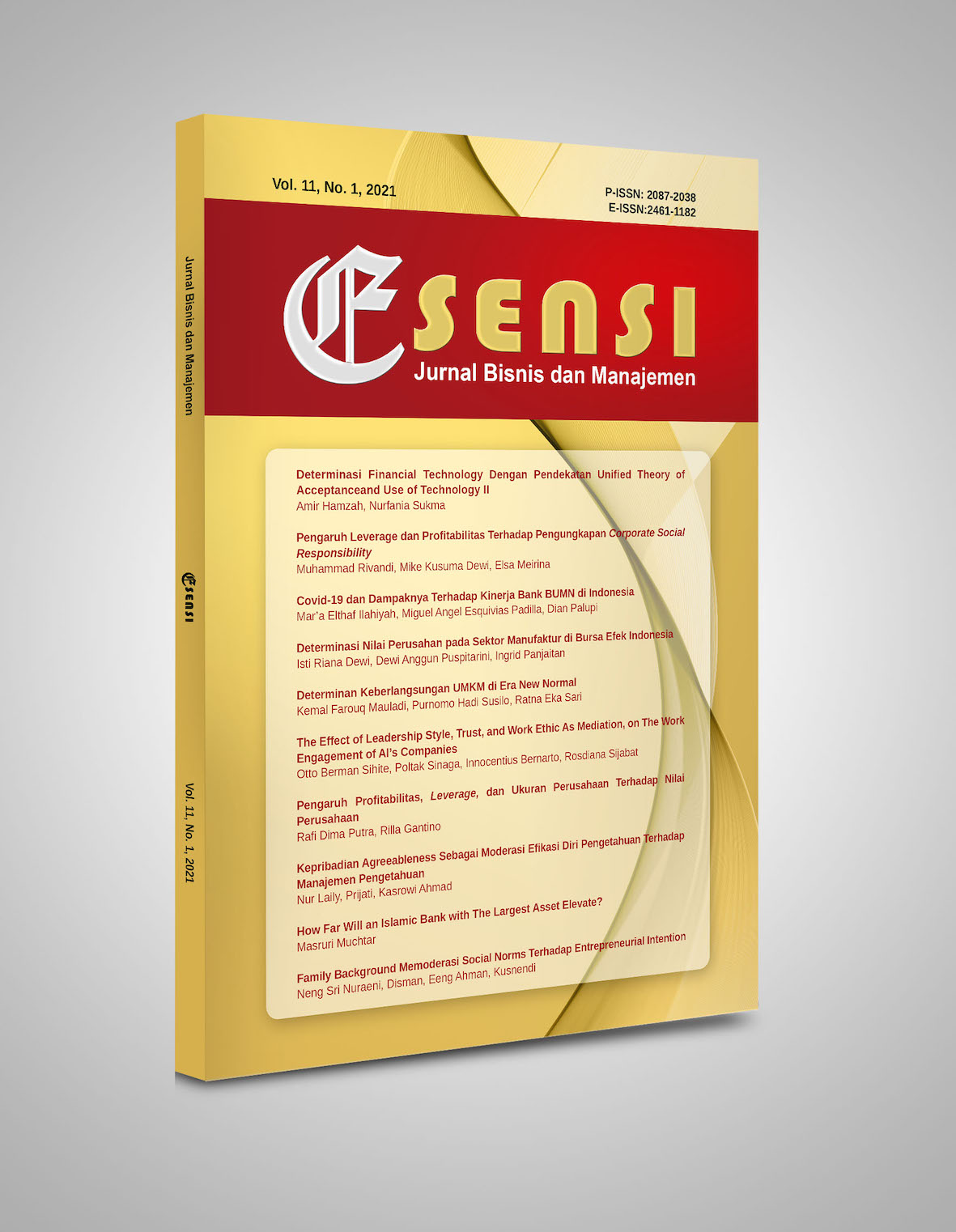How Far Will an Islamic Bank with The Largest Asset Elevate?
DOI:
https://doi.org/10.15408/ess.v11i1.20393Keywords:
efficiency, profitability, Islamic bankAbstract
Indonesian Islamic banking continues to show positive developments. Banking assets, the amount of financing, and third party funds continues to grow. A critical question arises particularly related to the issue of efficiency and effectiveness. This study is aimed to assess the level of efficiency of Bank of Shariah Mandiri (BSM) as an Islamic bank with the largest asset and to analyze factors that affect its level of profitability over the period of 2001-2019. Data Envelope Analysis was employed to assess efficiency and ordinary least square regression was applied for profitability analysis. The results show that the level of efficiency of BSM is categorized high with an average efficiency score of 97.7% but with the average level of profitability of only 1.3%, which is considered as medium. The level of efficiency was at the lowest point in 2003. Non-Performing Financing (NPF), Financing to Deposits Ratio (FDR), Operational Cost to Operational Income (BOPO), and Capital Adequacy Ratio (CAR) simultaneously have a significant effect on the level of profitability, but independently, FDR does not. The results imply that an Islamic bank with a gigantic asset shall give attention to its profitability while maintaining efficiency level.
Cara Mengutip:Muchtar, M. (2021). How Far Will an Islamic Bank With The Largest Asset Elevate? Esensi: Jurnal Bisnis dan Manajemen, 11(1), xx-xx. https://doi.org/10.15408/ess.v11i1.20393.
References
Abdillah, R., Hosen, M. N., & Muhari, S. (2016). The Determinants Factor of Islamic Bank’s Profitability and Liquidity in Indonesia. Knowledge Horizons. Economics, 8(2), 140–147.
Abdul-Wahab, A. H., & Haron, R. (2017). Efficiency of Qatari Banking Industry: an Empirical Investigation. International Journal of Bank Marketing, 35(2), 298-318. https://doi.org/http://dx.doi.org/10.1108/IJBM-07-2016-0090
Anagnostopoulos, I., Noikokyris, E., & Giannopoulos, G. (2020). A Meta-Crisis Banking Efficiency: Study in The MENA Region. Journal of Islamic Accounting and Business Research, 11(9), 2087-2112. https://doi.org/10.1108/JIABR-12-2019-0235
Ascarya., & Yumanita, D. (2008). Comparing The Efficiency of Islamic Banks in Malaysia and Indonesia. Buletin Ekonomi Moneter dan Perbankan, 11(2), 95-105.
Ascarya, & Yumanita, D. (2006). Analisis Efisiensi Perbankan Syariah di Indonesia. TAZKIA Islamic Finance and Business Review, 1(2), 91-100.
Banker, R. D., Charnes, A., and Cooper, W. W. (1984). Some Models for Estimating Technical and Scale Inefficiency in Data Envelopment Analysis. Management Science, 30(9), 1078-1092.
Charnes, A., Cooper, W.W., and Rhodes, E. (1978). Measuring the Efficiency of Decision Making Units. European Journal of Operation Research, 2, 429–444.
Firdaus, M. F., & Hosen, M. N. (2013). Efficiency of Islamic Banks Using Two Stage Approach of Data Envelopment Analysis. Bulletin of Monetary, Economics and Banking, 16(2), 155–176.
Haron, S. (2004). Determinants of Islamic Bank Profitability. KLBS Working Paper Series No.02.
Hosen, M. N., & Rahmawati, R. (2016). Efficiency and Profitability on Indonesian Islamic Banking Industry. Al-Iqtishad: Journal of Islamic Economics, 8(1), 33–48. https://doi.org/10.15408/aiq.v8i1.2507
Kamyab, P., Mozaffari, M. R., Gerami, J., & Wanke, P. F. (2020). Two-Stage Incentives System for Commercial Banks Based on Centralized Resource Allocation Model in DEA-R. International Journal of Productivity and Performance Management, 70(2), 427-458. https://doi.org/10.1108/IJPPM-11-2018-0396.
Mostafa, M. M. (2011). Modeling Islamic Banks’ Efficiency: a Non-Parametric Frontier Approach. International Journal of Islamic and Middle Eastern Finance and Management, 4(1), 7–29. https://doi.org/10.1108/17538391111122186
Nasution, L. N., Novalina, A., & Faried, A. I. (2019). Financial Performance and Profitability of Islamic Banking on Economic Growth In Indonesia. 1st International Halal Conference & Exhibition 2019, 28–34.
Parman, B. J., & Featherstone, A. M. (2019). A Comparison of Parametric and Nonparametric Estimation Methods for Cost Frontiers and Economic Measures. Journal of Applied Economics, 22(1), 59–84. https://doi.org/10.1080/15140326.2018.1526868
Rusydiana, A. S. (2018). Efisiensi dan Stabilitas Bank Umum Syariah di Indonesia. Akuntabilitas, 11(2), 203–222. https://doi.org/10.15408/akt.v11i2.7033
Sakti, M. R. P., & Azhar, M. (2018). Efficiency, Stability, and Asset Quality of Islamic vis-à-vis Conventional Banks: Evidence from Indonesia. Journal of Islamic Accounting and Business Research, 9(3), 378-400. https://doi.org/10.1108/JIABR-07-2015-0031.
Srairi, S., & Kouki, i. (2012). Efficiency and Stock Market Performance of Islamic Banks in GCC Countries. ISRA International Journal of Islamic Finance, 4(2), 89-116.
Sufian, F., & Kamarudin, F. (2015). Determinants of Revenue Efficiency of Islamic Banks. International Journal of Islamic and Middle Eastern Finance and Management, 8(1), 36–63. https://doi.org/10.1108/imefm-12-2012-0114
Suntoto, D. (2013). Analisis Laporan Keuangan Untuk Bisnis. CAPS: Yogyakarta.
Tabari, N. A. Y., Ahmadi, M., & Emami, M. (2013). The Effect of Liquidity Risk on the Performance of Commercial Banks. International Research Journal of Applied and Basic Sciences, 4(6), 1624-1631.
Triola, M. F. (2011). Essentials of Statistics 5th Edition. Pearson College Division: New York.
Wasiuzzaman, S., & Hanimas. (2013). Profitability of Islamic Banks in Malaysia: An Empirical Analysis. Journal of Islamic Economics, Banking Finance, 6(4), 53-68.

